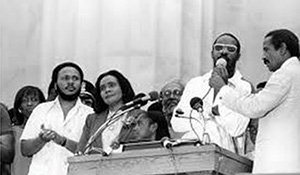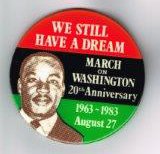Stevie Wonder, Pete Seeger and Peter, Paul and Mary were among the singing performers that I remember. Congresswoman Bella Abzug waved her fist and gave it her all. Mrs. Coretta Scott King spoke early in the long afternoon of speakers. I don’t remember Rev. Joseph Lowery’s speech, although both he and Mrs. King were co-chairs of the August 27, 1983 March on Washington for Jobs, Peace and Freedom. It was the 20th anniversary of the historic 1963 event. Among the 23 conveners of that 1983 march, were the leaders of four unions, Clyde Bellancourt from the American Indian Movement, Dorothy Height from the National Council of Negro Women and Judy Goldsmith from the National Organization for Women. The heat caused the crowd of over 200,000 to fizzle, or wade in the reflecting pools at the Lincoln Memorial before the speeches ended. Rev. Benjamin Hooks from the NAACP only came to the microphone after two hours or more had droned on.
 It was a different time. Trade unions membership was 20.1% of the workforce, almost nine points higher than it is today. President Ronald Reagan was in his first term, and doing everything he could to reduce that number. He succeeded to some degree. All the speakers denounced Reagan and Reaganomics and promised to un-elect him in 1984. They failed.
It was a different time. Trade unions membership was 20.1% of the workforce, almost nine points higher than it is today. President Ronald Reagan was in his first term, and doing everything he could to reduce that number. He succeeded to some degree. All the speakers denounced Reagan and Reaganomics and promised to un-elect him in 1984. They failed.
Klan groups still had between 8,000 and 9,000 members, and the states with the most rapid growth at that time were Georgia and North Carolina, according to a May 1983 report to the National Anti-Klan Network (NAKN) executive committee. My report to that meeting included information on Gordon Kahl and the Posse Comitatus, the Christian Patriots Defense League and other paramilitary white supremacists. Willis Carto’s Liberty Lobby was sold from newsstands in Minot, North Dakota.
 At the March on Washington, NAKN announced a lawsuit by multiple victims of racist violence against the Reagan Justice Department for their failure to vigorously prosecute the perpetrators. In the case of Ms. Fanny Crumsey of Chattanooga, who in 1980 had been shot at by Klansmen while she walked down the street, Assistant Attorney General Bradford Reynolds declined to prosecute. He claimed there was no constitutional right to walk down the street. The Center for Constitutional Rights provided lawyers for the suit. At a vigil outside the Justice Department, speakers included Carolyn Goodman and Julia Chaney Moss, two women who had lost loved ones in one of the many horrific crimes during civil rights era.
At the March on Washington, NAKN announced a lawsuit by multiple victims of racist violence against the Reagan Justice Department for their failure to vigorously prosecute the perpetrators. In the case of Ms. Fanny Crumsey of Chattanooga, who in 1980 had been shot at by Klansmen while she walked down the street, Assistant Attorney General Bradford Reynolds declined to prosecute. He claimed there was no constitutional right to walk down the street. The Center for Constitutional Rights provided lawyers for the suit. At a vigil outside the Justice Department, speakers included Carolyn Goodman and Julia Chaney Moss, two women who had lost loved ones in one of the many horrific crimes during civil rights era.
That march twenty years ago remains with me. I kept the button because of what we did there. The central tasks of that day, however, remain to be completed.



